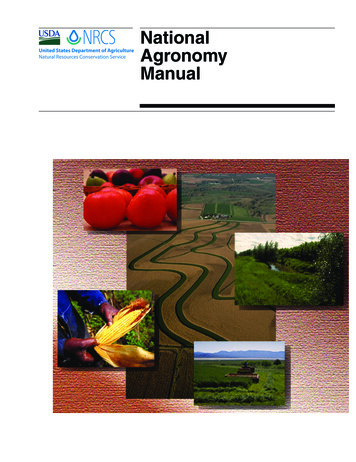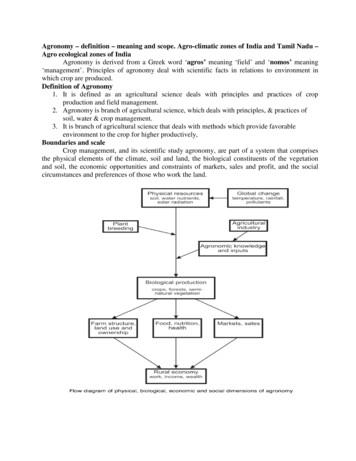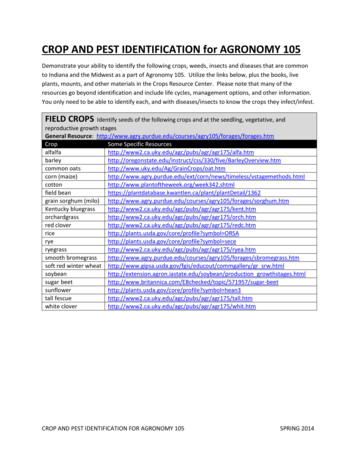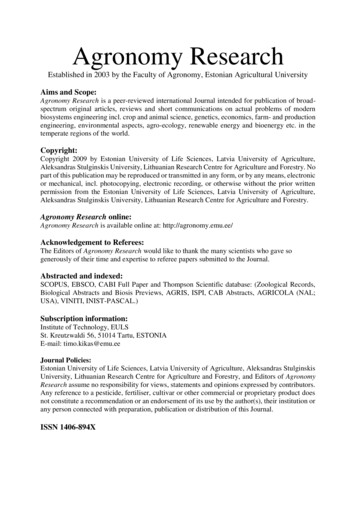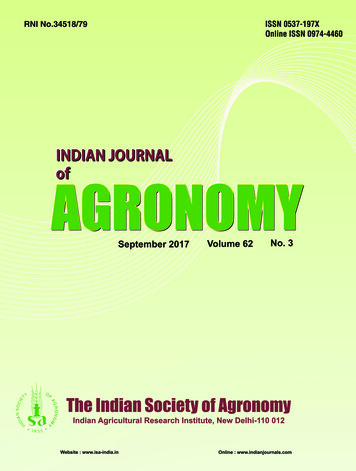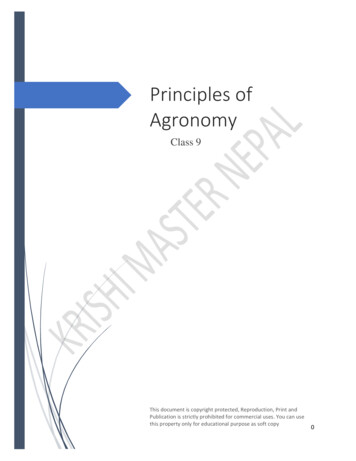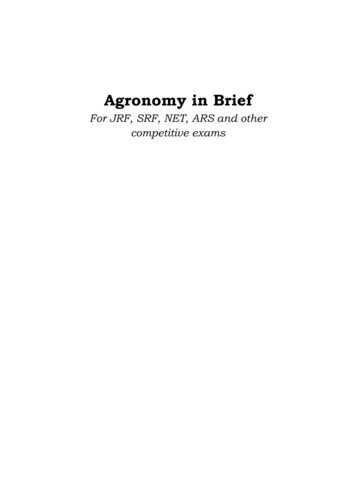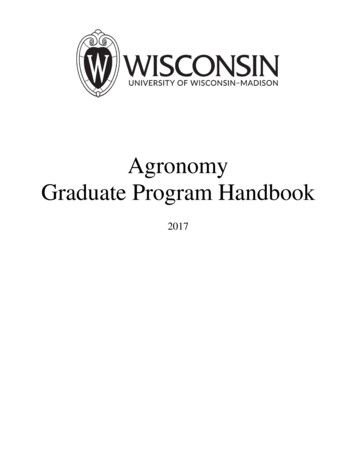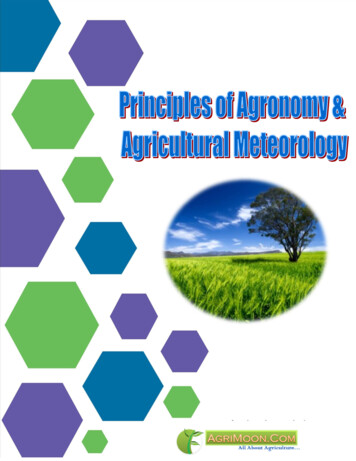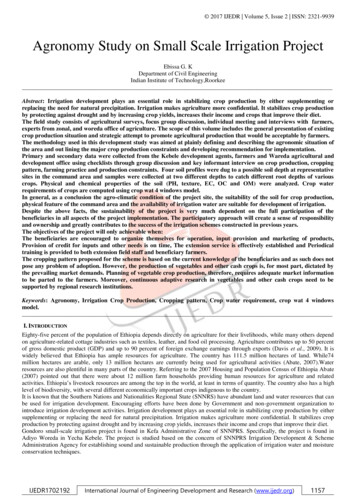
Transcription
2017 IJEDR Volume 5, Issue 2 ISSN: 2321-9939Agronomy Study on Small Scale Irrigation ProjectEbissa G. KDepartment of Civil EngineeringIndian Institute of Technology,RoorkeeAbstract: Irrigation development plays an essential role in stabilizing crop production by either supplementing orreplacing the need for natural precipitation. Irrigation makes agriculture more confidential. It stabilizes crop productionby protecting against drought and by increasing crop yields, increases their income and crops that improve their diet.The field study consists of agricultural surveys, focus group discussion, individual meeting and interviews with farmers,experts from zonal, and woreda office of agriculture. The scope of this volume includes the general presentation of existingcrop production situation and strategic attempt to promote agricultural production that would be acceptable by farmers.The methodology used in this development study was aimed at plainly defining and describing the agronomic situation ofthe area and out lining the major crop production constraints and developing recommendation for implementation.Primary and secondary data were collected from the Kebele development agents, farmers and Wareda agricultural anddevelopment office using checklists through group discussion and key informant interview on crop production, croppingpattern, farming practice and production constraints. Four soil profiles were dug to a possible soil depth at representativesites in the command area and samples were collected at two different depths to catch different root depths of variouscrops. Physical and chemical properties of the soil (PH, texture, EC, OC and OM) were analyzed. Crop waterrequirements of crops are computed using crop wat 4 windows model.In general, as a conclusion the agro-climatic condition of the project site, the suitability of the soil for crop production,physical feature of the command area and the availability of irrigation water are suitable for development of irrigation.Despite the above facts, the sustainability of the project is very much dependent on the full participation of thebeneficiaries in all aspects of the project implementation. The participatory approach will create a sense of responsibilityand ownership and greatly contributes to the success of the irrigation schemes constructed in previous years.The objectives of the project will only achievable when:The beneficiaries are encouraged to organize themselves for operation, input provision and marketing of products,Provision of credit for inputs and other needs is on time, The extension service is effectively established and Periodicaltraining is provided to both extension field staff and beneficiary farmers.The cropping pattern proposed for the scheme is based on the current knowledge of the beneficiaries and as such does notpose any problem of adoption. However, the production of vegetables and other cash crops is, for most part, dictated bythe prevailing market demands. Planning of vegetable crop production, therefore, requires adequate market informationto be parted to the farmers. Moreover, continuous adaptive research in vegetables and other cash crops need to besupported by regional research institutions.Keywords: Agronomy, Irrigation Crop Production, Cropping pattern, Crop water requirement, crop wat 4 windowsmodel.I. INTRODUCTIONEighty-five percent of the population of Ethiopia depends directly on agriculture for their livelihoods, while many others dependon agriculture-related cottage industries such as textiles, leather, and food oil processing. Agriculture contributes up to 50 percentof gross domestic product (GDP) and up to 90 percent of foreign exchange earnings through exports (Davis et al., 2009). It iswidely believed that Ethiopia has ample resources for agriculture. The country has 111.5 million hectares of land. While74million hectares are arable, only 13 million hectares are currently being used for agricultural activities (Abate, 2007).Waterresources are also plentiful in many parts of the country. Referring to the 2007 Housing and Population Census of Ethiopia Abate(2007) pointed out that there were about 12 million farm households providing human resources for agriculture and relatedactivities. Ethiopia’s livestock resources are among the top in the world, at least in terms of quantity. The country also has a highlevel of biodiversity, with several different economically important crops indigenous to the country.It is known that the Southern Nations and Nationalities Regional State (SNNRS) have abundant land and water resources that canbe used for irrigation development. Encouraging efforts have been done by Government and non-government organization tointroduce irrigation development activities. Irrigation development plays an essential role in stabilizing crop production by eithersupplementing or replacing the need for natural precipitation. Irrigation makes agriculture more confidential. It stabilizes cropproduction by protecting against drought and by increasing crop yields, increases their income and crops that improve their diet.Gondoro small-scale irrigation project is found in Kefa Administrative Zone of SNNPRS. Specifically, the project is found inAdiyo Woreda in Yecha Kebele. The project is studied based on the concern of SNNPRS Irrigation Development & SchemeAdministration Agency for establishing sound and sustainable production through the application of irrigation water and moistureconservation techniques.IJEDR1702192International Journal of Engineering Development and Research (www.ijedr.org)1157
2017 IJEDR Volume 5, Issue 2 ISSN: 2321-9939The field study consists of agricultural surveys, focus group discussion, individual meeting and interviews with farmers, expertsfrom zonal, and woreda office of agriculture. The scope of this volume includes the general presentation of existing cropproduction situation and strategic attempt to promote agricultural production that would be acceptable by farmers.The aim of this paper is to estimate (1)To evaluate the existing agricultural situation of the area including crops grown, thecropping pattern and farming practice, (2) To propose the necessary interventions and ensure the possible increase in productivity,(3) To investigate the suitability of soil, climate and water to irrigated agriculture, (4) To estimate crop water requirements and (5)To estimate input requirements of irrigated cropsII. STUDY AREA2.1 Description of the Project Area2.1.1 LocationGondoro river diversion irrigation project is found in Southern Ethiopia nation, nationality and people’s regional state, Kefaadministrative zone of Adiyo woreda at Yecha kebele. It is found on 64 km away from the zone town, Bonga. The project area issituated at 4.5km far from woreda town, Kaka, from which 2.5km is all weather road and the rest 2km is only dry weather road.2.1.2 ClimateAccording to agro ecological classification the kebele consists of major, kola (55%) woina- dega (29.5%),and dega(15.5%).(Woreda and kebele agricultural office).2.1.2.1 Rain FallThe rainfall pattern of the project area is bimodal type in which one main rainy season is occurred during the summer seasonmostly starting in June and ends in September. Even though, there is no regular time of staring for the belg rain usually it startsafter two to three months of break. The major rain is received in the months of July and August (Table 1).MonthMean monthly rain fallJan39.3Table 1: The mean monthly rainfall of the area (mm)Feb MarAprMay JunJulAugSep31.9 117.0 180.1 189.7 199.1 200.4 208.5 196.9Oct150.1Nov73.2Dec62.1Total2.1.1.2 TemperatureThe mean maximum average annual temperature of the area is 27.2 0c and the mean minimum average annual temperature of 12 0c,in which the highest mean maximum temperature of 29.3 0C and a mean minimum temperature of 10.50C were recorded in Marchand December months respectivelyMonthMean Max. Temp.Mean Min. Temp.Jan28.410.6Feb29.110.9Table 2: Mean max. and min temperature (oc)MarAprMay JunJulAug Sep29.3 27.8 27.526.0 25.9 25.8 26.012.0 13.0 12.812.8 12.4 12.7 .02.1.3 TopographyThe command area begins immediately from the head work. The left side of the command starting from the headwork is boundedby a hilly mountain covered with natural vegetation.The command area has undulating topography. The agro forestry system, crops under scattered trees, is practiced in the area.Generally the slope of the area is from 2-15%. Therefore, the furrow alignment, planting geometry and irrigation applicationmethod has to be considered.2.1.4 Land Use of the KebelesLand use of the kebele is mainly forest land, coffee plantation and cultivated land of rain fed based production system. The forestcover accounts up to 19.4% of the total area of the kebele.Table 3: Land use pattern of the kebeleLand useArea(has) %1. Cultivated land 97229.012. Grazing land178.55.323. Forest : kebele development office2.1.5 Methodology of the studyThe methodology used in this development study was aimed at plainly defining and describing the agronomic situation of the areaand out lining the major crop production constraints and developing recommendation for implementation.IJEDR1702192International Journal of Engineering Development and Research (www.ijedr.org)1158
2017 IJEDR Volume 5, Issue 2 ISSN: 2321-9939Primary and secondary data were collected from the Kebele development agents, farmers and Wareda agricultural anddevelopment office using checklists through group discussion and key informant interview on crop production, cropping pattern,farming practice and production constraints. Four soil profiles were dug to a possible soil depth at representative sites in thecommand area and samples were collected at two different depths to catch different root depths of various crops. Physical andchemical properties of the soil (PH, texture, EC, OC and OM) were analyzed. Crop water requirements of crops are computedusing crop wat 4 windows model.III. RESULTS AND DISCUSSION3.1 Crop Production in the Project Area3.1.1Rain Fed Crop ProductionExisting Cropping PatternIn the kebele agriculture is mainly dependant on rainfall and it is dominated by the production of sol crop maize, tef, wheat,barley, F.bean, sorghum and coffee. Banana and Enset are grown in most of the households around there homestead and it is amain source of food and cash income for the households. The system of production is traditional one in which plowing,harvesting and threshing is done by human and animal power only. Crops grown in the command area are Maize, tef, sorghum,wheat, barley and F. bean. Previous years Cropping pattern of the kebele for their total cultivated land is shown below. Table 4: Existing cropping pattern of the ef165.25Barley42.625Sorghum28.75Millet12.5PulseF. Bean26.75Fieldpea27.625Vegetable and fruits( Banana, Onion, Enset, carrot, cabbage)and 475.25CoffeeTotal972Source: kebele development officeNa- Data not available, *Improved seed with fertilizerTable 5: Crop calendar for major cropsCropLand Preparation Sowing dateWeeding dateMaizeJan – MarchMar – MayApr-MayTefMay-JunJuly12- Aug15AugWheatMar- JunJuly1- 30AugBarleyMay - JulyJuly 15- Aug 30 SeptemberSorghum Feb- MarApr- MayJun- OctF.beanMay-JunJun15- July30SeptemberSource: kebele development office & field ing dataAug -SepOct- NovDecNov15-DecNovemberOctober(end)3.1.2 Production FactorsLandThe maximum land holding of a household extends up to 10 hectare. The lowest land holding is 0.5 hectare and averagelandholding of the kebele is 3.5 hectare. The average land holding size of the households is decreasing through years ascompared to the previous years. This land holding may decrease more due to the annual increment of rural population. In suchsituation to satisfy additional food requirement, higher yields would only achieved by through the application of irrigation waterand use of appropriate farm management including the introduction of improved farm inputs and implements as well as bettercultivation technique.Animal PowerOxen are the most commonly used draft power in the kebele. Donkeys and horses are also another source of animal power fortransporting agricultural products to the market and for any other purpose. 75% of the household possess one and above oxen,and only 15% of the household has no any ox.IJEDR1702192International Journal of Engineering Development and Research (www.ijedr.org)1159
2017 IJEDR Volume 5, Issue 2 ISSN: 2321-9939No.12345Table 6: Number of oxen per household at the kebeleNo. of oxenNo.of HouseholdsNo. of HH who posses nil ox55No. of HH who posses one ox only86No. of HH who posses two oxen135No. of HH who posses three oxen74No. of HH who posses four and above 7Total357Source: kebele development office%15.424.0837.8120.721.96100InputMajor inputs used in the area are fertilizers and improved seeds. Fertilizer is applied for crops mainly for maize, wheat and tef.Improved seed is used for maize and wheat only. Application of inputs (fertilizer and improved seed) is increasing from time totime. The basis for this is farmer’s attitude on fertilizer and improved seed is changed, farmers realize the yield obtained fromimproved technologies is by far better than from the conventional one.In the 2009/10 cropping season a total of 300.5qt DAP and Urea and 49.25qt of improved seed was utilized by the kebele.Whereas in the 2010/11 cropping season a total of 555 qt DAP and Urea and 180.5 qt improved seed was used.The major problems in input use in the kebele are: Lack of on time delivery of inputs, Lack of accessible roads up to the Kebele,Different varieties of improved seeds are not delivered, High input price, and Lack of skilled manpowerTable 7: Existing man days and oxen days for major cropsTef Wheat Maize F. bean SorghumMan 161212812Land preparationoxen ion-4-4Bird 0132975890Total1620201224Source: field survey and kebele development officeBarley1248440---12-8128020Farming PracticeLand Preparation:-Land preparation is done by using the traditional way of plow drawn by two oxen. The number of plowingvary from one crop to another, within a given crop also the frequency of plowing vary due to the presence or absence of enoughlabor and animal power.Sowing and weeding/ cultivation:-The method of sowing for most of the crops is by broad casting. After the crop has sown,weeding is practiced to decrease the competition of weeds for nutrients, light and moisture. Therefore, weeding is practicedthrough hand weeding, for maize there is a traditional practice called ‘shelshalo’. They also use 2,4D for most of the crops.Harvesting and Threshing:-Harvesting is done by hand picking and with the help of sickles; this is done when the crop reach atmaturity. The harvested crop is collected and transported to winnowing area and left for some time to decrease the moisturecontent of the grain. When it becomes dry they run over animals to separate the grain from its cover.Table 8: Frequency of plowing and weeding for major cropsCropFrequency of plowing Frequency of weedingTef41-2Maize3-42(one Shelshalo)Wheat42F. bean2Sorghum 21-2(and 2,4D)Barley3-42Source: field survey and kebele development office3.1.3 Cropping SystemThe dominant cropping system practiced in the kebele is sol cropping of tef, maize, F.bean, wheat, Barley and sorghum. Mixedcropping of maize with cabbage, is practiced in the project area to a limited extent. Farmers rotate crops with their limitedoptions.IJEDR1702192International Journal of Engineering Development and Research (www.ijedr.org)1160
2017 IJEDR Volume 5, Issue 2 ISSN: 2321-9939Therefore, the common crop rotations practiced by the farmer in the area are:Maize --- TefMaize --- Wheat/BarleyWheat --- F.bean/F.pea3.1.4 Agricultural ExtensionLike any other areas of the region, the agricultural extension system in the woreda is agricultural training and advisory extensionsystem. Two types of extension approaches/ packages are under implementation (minimum and family package). Agriculturalextension has been given by the development agents. The development agents supervise the farmers and give technical supportabout the preparation of compost, fertilizer application, making terrace, forage production. .In the Kebele there aredevelopment agents having different profession (cooperative, plant science and natural resource).3.1.5 Crop ProtectionIn addition to the other factors, which has great impact on crop production, a significant amount of yield is lost due to pests, thesepests include insect pests, diseases, weeds and rodents causing losses at both the pre harvest and post harvest stages.The types of crop pests are different depending on the type of host crop. So, important crop insect pests, diseases and weeds andthe existing control measures are mentioned below.CropMaizeF.beanSorghumTefWheatBarleyTable 9: Major crop pests of main cropsInsect pestsDiseasesControl measureStalk borer, weevils, monkeys- Field sanitationAfrican ballwormWeevils, aphids - Bacterial wilt - adding ash to the field- Animal urine- root rotWeevils,shoot fly, beetlesBarley flyRust, smutBarley flyRust, smutSource: field survey and kebele agricultural officeIn addition to insect pests and diseases, weeds are also causing a significant yield loss, through competition for nutrients, light andmoisture, as a host plant for insect pests and diseases, and used as an oviposition site. Weeds are great problems to the farmersdue to its high demand for labor to remove the weed. The dominant weeds present in the farmland area are, cucrbits, Cyprus spps,Eragrosties cilianensis, and others. The farmers control these weeds by hand weeding and apply 2-4 D.3.1.6 Major Constraints of AgricultureLack of varieties of improved seed, Erratic nature of the rain fall, Crop insect pest, disease and weed infestation, In accessibilityof most of the kebeles to deliver inputs, and Lack of trained manpower at Woreda as well as kebele level3.2 Traditional IrrigationThere is no well practiced traditional irrigation in the project site. However, elementary schools found in the village divertGondoro River traditionally and use it to produce vegetable crops and coffee seedlings. But some few farmers able to produce fewvegetable crops fetching water using cans from the canal.3. 3 Irrigation Crop Production3.3.1 Rational and ObjectivesCrop production in the project area is mainly relying on rainfall only one major production season per year. In the project areaagriculture comprises both crop and livestock production. Grain is produced under rain fed condition using the traditional oxdrawn plow by smallholder farmers at subsistence level. Few farmers use a low input and most of the farmers do not use inputs.Farmers use low yielding local crop varieties with very small amounts of agro-inputs. Crop production is severely affected by theutilization of back ward farming practices, less diversified crops, and incidence of different crop pests. All these lead to very lowcrop yields and low standard of living.On top of the above facts, there is a need to supplement the rain fed production with irrigation and cultivate the land under fullirrigation during the dry season by providing different crop types in order to meet the objective of increasing household income,provide food throughout the year for the family, and generally increase the living standard of the people.Implementation of Gondoro irrigation project is aimed at increasing crop production as well as income of farmers in the projectarea through the application or use of improved technologies and agricultural inputs and by applying irrigation water fromGondoro river diversion to supplement the rain fed production and for the dry season irrigation for about 80 ha of land.The objectives of Gondoro irrigation project are: Develop 80 hectares of land for full and supplemental irrigation, Recommendcropping pattern for irrigated farming, Determine input requirement for the proposed scheme, and Realize higher crop yields andraise the household income of the beneficiaries.IJEDR1702192International Journal of Engineering Development and Research (www.ijedr.org)1161
2017 IJEDR Volume 5, Issue 2 ISSN: 2321-99393.3.2 Proposed Cropping PatternThe proposed cropping pattern for the project area in the wet season includes Maize, tef, wheat, Barley and F.bean. During thedry season onion, garlic, cabbage, maize, carrot and fruit trees mainly coffee are proposed. The wet season cropping calendarranges from May to November. Planting of the dry season cropping staggered from December to January targeting the marketdemand household food scarcity, and allowing enough time for the land preparation to the proceeding crop.The above crops are selected based on farmers preference, value of the crops, labor required for production, feeding habit of thepeople and environmental requirements of the crops (suitability of the soil and the prevailing climate).Table 10: Proposed cropping pattern%Area(ha)Wet season. Maize108. Tef4536. F.bean54. Wheat2016. Barley108. Fruit trees 108Dry season. Onion3024. Garlic3024. Cabbage108.Carrot54.Maize1512. fruit trees108Total100 80The cropping pattern is revised according to the market demand, farmer's diet change and other factors.The proposed cropping pattern has advantageous for by bringing a certain level of annual income, changes the feeding habit of thefamily by providing different nutritional contents, improves efficient use of natural resources and ultimately secure householdfood security.CropWet SeasonMaizeTefF.beanWheatBarleyDry SeasonTable 11 Crop calendar for proposed crops.Land preparation Planting TimeOnionGarlicCabbageCarrot.MaizeHarvesting TimeApril-MayMay-JuneMay- rOctoberOctoberOctoberNov- DecNov- DecDecemberNov - DecDecemberLate Decemberlate DecemberJanlate DecemberJanEarly AprilAprilAprilMarchEarly May3.3.3 Irrigation System and MethodIrrigation is supplementing rainfall for crop production by bringing surface water or ground water from a surface to fields.Artificial supply of water is needed for ensuring a regular supplement of water during the wet season and providing irrigationduring the dry season. Gondoro irrigation project has an irrigation system of diverting Gondoro River. The method of irrigationproposed is furrow, which is suitable for soils of regular topography and medium and heavy soils, reduces the losses due toevaporation, and minimizes the puddling hazard in heavy soil.Table 12: Method of irrigation for proposed cropsCrop Method of irrigationMaizeFurrow, rrowFruit treesRing (basin)IJEDR1702192International Journal of Engineering Development and Research (www.ijedr.org)1162
2017 IJEDR Volume 5, Issue 2 ISSN: 2321-99393.3.4 Irrigation SchedulingField irrigation schedules are based on the field water balance and are expressed in depth and interval of irrigation. Too frequentsmall application of water tend to reduce irrigation efficiency and also time consuming for the farmer, delayed irrigation on theother hand particularly when the crop is sensitive to water stress could affect yields which cannot be compensated for bysubsequent over watering. Therefore, correct time of irrigation application has great importance for the crop as well as to useeffectively the scarce water.CropWet SeasonTefMaizewheatBarleyF.beanDry sSeasonOnionGarlicMaizeCarrotCabbageFruitCropWet SeasonTefMaizewheatBarleyF.beanDry SeasonOnionGarlicMaizeCarrotCabbageFruitNIRGIRDuty for 12hrCrop%JanTable 13: Irrigation water requirement (mm/month)FebMarAprMay Jun Jul Aug 8940.251.410001.79Table 14: Net irrigation requirement (mm/month)FebMarAprMay Jun .232.460.06.846.8413.680.1Table 15: Irrigation interval and depth of application for proposed cropsCropIrrigationMaximum Fraction TotalRooting Depth ofevapotranspiration waterETCofavailable soil depthapplication(mm/season)requirement (mm/day) available rotFruittreesSoil type: Silt clay loamTotal available soil water (sa): 200mm/m9.1015.9131.820.2irrigationintervalI p.sa.d/Etcropdays4254811253.3.5 Irrigation Water ManagementThe method of irrigation proposed for the project is furrow and the alignment should be across the slope but with some gradients.Thus, water can move through. The crop has to be sown in rows with layout furrows so water application and other agronomicpractices can be easily done.IJEDR1702192International Journal of Engineering Development and Research (www.ijedr.org)1163
2017 IJEDR Volume 5, Issue 2 ISSN: 2321-9939By considering farmers experience for irrigation and management of the canals and to reduce loss of water during excessive timeof application twelve hours daytime irrigation is proposed.3.3.6 Organizational Aspects of the ProjectA permanent solution for all irrigation water management problems is to involve participation of farmers for water distributionright from the stage of release of water from the headwork up to its uptake by the plant and make them responsible formaintenance of the irrigation system. Participation of farmers in irrigation water management implies a significant role for themin decision-making.The farmers’ participation should be through legal bodies by establishing water users association, which has a supremecommittees and sub committees organized, based on neighboring farms or blocks.The main committee should include farmers, development agents and kebele administrative council. The committee can controland manage the irrigation scheme by deciding seasonal water allocation water balance and operational plan, Controls outlets andstructures, ensure equitable distribution of water to all the farmers, repair and maintain the irrigation system during damage anddevelop by-laws and execute accordingly. The subcommittee also has a duty of preparing timetable for irrigation, control waterdistribution and cleaning canals within their blocks.In addition to this farmers should be organized into cooperatives so that they can get inputs through their cooperative. Thecooperative also help them to search better price for their produce.3.3.7 Extension and Research DemonstrationDespite of the fact that, there is an already existing extension system in different agricultural activities it is not effective as of itsstage. So, to identify and overcome production problems at the farm level there should be a strong linkage between farmers,researchers and extension staff. The primary extension technique would be participatory technology development, supplementedand supported through a variety of other modern extension systems. Moreover it is better to use the elementary school situated inthe midst of the village as a demonstration site since it is already started this work by producing through traditional irrigation.3.3.8 Crop ProtectionTo have effective crop protection practice at household level as well as in the Kebele the following activities should be done, i.e.Identifying traditional pest control measures practiced by farmers and use this as part of the pest control measures; Supply thenecessary crop protection inputs on time, Pest monitoring at different pest development stage, Training of farmers, developmentagents and woreda experts on integrated pest management, Conduct on farm demonstration trail of pest control techniques, andImprove post harvest handling of crops and use biological control measures not to affect the environment and crop quality.3.3.9 Input RequirementThe main agricultural inputs are fertilizer, improved seed and arrotCabbageFruit trees/CoffeeTable 16: Input requirements for proposed cropsSeed rate (kg/ha) Fertilizer (kg/ha)PesticideDAPUrea25-30100100Enosulfan5% dust 7.8kg/ha2.5 kg/ha mancozeb100-120- 3.5 kg/ha Ridomil20 - 3010050150 50 seed ling100/year 80/yearHerbicide1lt, 24-DTable 17: Man and oxen days per hectare required for proposed cropsMan days oxen daysWest seasonMaize10220F. bean6422Tef12530Wheat13030Barley11016Day bbage23620IJEDR1702192International Journal of Engineering Development and Research (www.ijedr.org)1164
2017 IJEDR Volume 5, Issue 2 ISSN: 2321-9939Fruit trees/coffee280103.3.10 Yield ProjectionTo build the yield of the proposed crops throughout the project year references are used on results obtained from research centers,on farm trials and demonstration sites, existing yield of the farmer and the ability to adopt and practice the proposed agriculturalpractices and so on. The yield of the proposed crops increases with a smaller rate at the start and increases when the extensionservices become strong and farmers’ awareness for technologies escalates.Table 18: Yield build up of irrigate
Keywords: Agronomy, Irrigation Crop Production, Cropping pattern, Crop water requirement, crop wat 4 windows model. _ I. INTRODUCTION Eighty-five percent of the population of Ethiopia depends directly on agriculture for their livelihoods, while many others depend .

